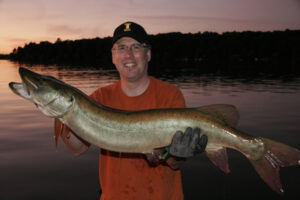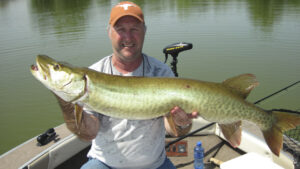By Steve Heiting
My custom before launching my boat is to inspect the ramp to check for any surprises that may damage my rig. At one time or another, I’ve spotted broken cement pads, exposed rebar, broken glass and logs, all of which have prompted me to back my trailer in at a different angle or, in extreme cases, go on to another lake altogether.
Stepping onto the pier that August evening last year, I was greeted by a sea of green algae that slowly ebbed and flowed with the slight wave action, blocking my view of what lay beneath the water’s surface. Making the water’s appearance even more “special,” strands of northern milfoil, a dead bluegill, and a mass of some kind of green gunk lay mixed in the algae. “It looks like a leprechaun got sick on pea soup,” I joked to myself, and went about preparing my boat to launch.

Three hours later only a sliver of sun peeked over the treeline. My friend, Kevin Lynch, launched his topwater for the umpteenth time over the shallow bar and snaked it through the occasional weed tangle that blotted the surface. As the prop bait neared the boat the water bulged as a musky swirled but missed its mark. Kevin took the lure into a big figure-8 and the lake exploded as the predator latched on. A minute or so later Kevin’s fish — the largest of his life to date —was in the net. After a few photos the fish was happily back in the swill it called home, and shot off with a snap of its tail.
Fast-forward to mid May and I had joined friend John Bette of Stealth Tackle on an Indiana water. “I can’t believe this. I’ve never seen this lake so green,” John said, as the bright sun beat down through windless skies. Our day had become a cast-retrieve-figure-8, cast-retrieve-figure-8 repetition when John shouted “I’ve got one!” A dandy musky had sucked in John’s Mini Medussa as he slowly swam it over shallow weeds and now battled invisibly in the green murk. Soon it was at the surface and in the net, and after photos it too was released.
Algae blooms are a fact of life for musky fishermen, especially in late summer following what some call the “dog days” of August. Given the right conditions, they can occur earlier in the summer, as John and I experienced, and are impossible to predict. An unusually warm spring, little wind in the week preceding our fishing outing, and water temperatures in the high 70s likely triggered the greenery.
Explains Musky Hunter Research Editor Steve Pallo, former chief of the Illinois Department of Natural Resources’ fisheries department, “Blooms usually happen at or near peak water temperatures, usually when they approach 80 degrees in very late July or August.”
Jordan Weeks, MHM’s other research editor and a Wisconsin DNR fisheries biologist, took Pallo’s explanation a step further. “This phenomenon occurs most often when the water is warm and the weather is calm. High temperature and abundant sunlight are the ‘keys to the car.’ Waters that flow

slowly with low turbulence … are at particularly high risk for algal blooms.”
Blooms in freshwater lakes typically involve blue-green algae, which occur naturally in the environment’s food chain and are not an indicator of poor water quality. In fact, pristine Lake of the Woods turns green with bloom in late summer. Blooms dissipate naturally, and usually will clear up completely after a lake turns over. Still, unseasonably warm fall weather, bright sun and little wind can spark a late bloom.
For the most part, musky hunters prefer to avoid bloom. The gunk stains T-shirts when it sprays off braided line, drips onto boat carpeting, and blocks your view of following fish. If muskies aren’t biting, it’s hard to develop a pattern when you can’t see how they’re reacting to your choice of presentation. Finally, it’s hard to maintain focus when you’re not seeing or catching fish. However, with a ramped-up, warm water metabolism, muskies have to feed and can readily be caught. You just have to know how to battle the bloom.
Chances are, if you’ve succeeded in bloom before, you spotted some of the keys to success in the anecdotes of Kevin’s and John’s muskies.
The Right Conditions
My first step when faced with algae bloom? I try to avoid it. Both wind and current can move bloom throughout a lake, and searching out areas where it has been minimized is the first key. Not only can the muskies see your bait better, but you can spot followers. If you don’t catch them now you know where they are and can return later when a condition change may trigger a bite.
On a trip a few years ago, friend Kevin Schmidt and I sought out areas where the bloom had been lessened by wind and boated giant muskies on back-to-back days, while others at the same camp struggled to even see fish. But all too often bloom can’t be avoided. It’s thick, it’s real, and it’s not going away anytime soon. A very specific set of tactics is necessary to succeed, the first of which is to fish in the very conditions that created it — bright sun — which somewhat penetrates the green haze and gives the muskies a chance to see your offering.
Conversely, the bloom bite seems to slow when night falls as the water may be simply too dark to permit efficient feeding. The muskies seem to know this, whether consciously or instinctively, because the last minutes before sundown can be the best of the entire day. Another factor that may affect night feeding by muskies in bloom conditions is reduced oxygen in the water.
“During the day, oxygen is produced via photosynthesis but at night that oxygen is consumed by respiration,” Weeks explained. “Nighttime respiration as well as the decay of the blue-green algae can consume much of the oxygen in the water.”
Whether it’s because they can see better, or the green cover makes them feel safe, muskies feeding in bloom seem to gravitate toward the shallows. Kevin Lynch’s musky was caught in only three feet of water while John’s came from about five feet. A famous northern Wisconsin lake that I know well has a distinct inside weed edge bite that seems to perfectly coincide with an algae bloom in late August. While I usually prefer to fish in a good chop, wind doesn’t seem to have much of an effect in bloom conditions — I’ve done well when it’s been blowing hard as well as when it’s been glass calm.
Persistent blooms can also block the sunlight needed for weed growth. Cabbage beds in bloom-choked bays may die in these conditions. Long ago I learned that while the occasional pike may be caught from dying, shallow weeds, muskies will be elsewhere. This is usually a great time to fish hard bottom areas.
Help The Muskies
So, if muskies living in bloom are having a hard time seeing your lure, you can’t see them follow, and they probably aren’t going to bite at night, how do you catch them? We’ve already discussed daytime fishing in shallow water, but your presentation is important, too. The water may be opaque, but you can make your lure stand out through water movement and color. Regardless of species, blind fish can survive by using their lateral line to feed, and we have to assume this sensory organ is important to fish living in bloom.
When you choose your lures, think water movement. Large lures provide a big target and move lots of water, and high-vibration lures move even more. Twin-ten (and larger) bucktails are tailor-made for bloom conditions, but multi-bladed spinnerbaits, propeller topwaters, crankbaits and even giant plastics move water, too.
In the cases of the opening anecdotes, both anglers were using lures that moved water. Kevin was casting a propellered topwater bait and fishing it with a steady retrieve, while the Medussa thrown by John was a mass of wiggly, blaze orange tails … which, as it turns out, was also a dynamite color selection.
Musky Hunter previously covered studies by Mepps of how various water colors filter the colors of lures (See “A Question Of Color, Musky Hunter, June/July 2005). To summarize how green (bloomed) water affects our lures, red is the first color to be filtered and turns almost black. Orange is also affected, but fluorescent (blaze) orange carries through. Black provides the most contrast. Because a fish’s perception of color changes rapidly based on the water color, daylight, the depth, and its distance from the lure, the key factor that came from Mepps’ study was that contrast was important regardless of water color. If you’re thinking firetiger (a mix of fluorescent chartreuse, fluorescent orange, and black) would be a highly effective color for bloom conditions, you’re on the right track. Black and blaze orange are great by themselves, too.
A slower, steady retrieve helps muskies home in the bait. Because it’s difficult to see follows, it’s even more important that you make a large, slow figure-8 after every cast (though you already should be doing this, anyway). I can’t even begin to count how many muskies I’ve caught in bloom on a figure-8 — suddenly, there’s a big musky head with an open mouth eating the lure at my feet.
So, to summarize, if you’re faced with bloom, target shallow areas during the day, but don’t skip the last-light bite. Use a large, high-vibration, lure that’s painted a high-contrast color, and fish it steadily before ending the retrieve with a big, slow figure-8. Algae blooms are challenging for musky hunters. But muskies still have to feed, so with the right approach at the right time you can succeed in the greenery. The smiles on Kevin’s and John’s faces in the photos should be all the proof you need.
